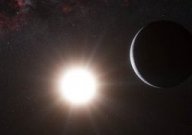Space & Astronomy
October 17, 2012 · 30 comments
30 comments

Image Credit: ESO
"Our observations extended over more than four years using the HARPS instrument and have revealed a tiny, but real, signal from a planet orbiting Alpha Centauri B every 3.2 days," said lead author Xavier Dumusque. "It's an extraordinary discovery and it has pushed our technique to the limit!"
Source: ESO.org | Comments (30)
Planet discovered in Alpha Centauri system
By T.K. RandallOctober 17, 2012 ·
 30 comments
30 comments
Image Credit: ESO
Astronomers have discovered an Earth-sized world in orbit around the next nearest star system to our own.
The small rocky planet is the lightest exoplanet ever discovered around a Sun-like star, it is also the nearest at just 4.3 light years. The Alpha Centauri system has long intrigued astronomers as it is the closest to us and is likely to be our first interstellar destination when future space-faring technology permits us to travel beyond the confines of our own solar system."Our observations extended over more than four years using the HARPS instrument and have revealed a tiny, but real, signal from a planet orbiting Alpha Centauri B every 3.2 days," said lead author Xavier Dumusque. "It's an extraordinary discovery and it has pushed our technique to the limit!"
European astronomers have discovered a planet with about the mass of the Earth orbiting a star in the Alpha Centauri system - the nearest to Earth.
Source: ESO.org | Comments (30)

The Unexplained Mysteries
Book of Weird News
AVAILABLE NOW
Take a walk on the weird side with this compilation of some of the weirdest stories ever to grace the pages of a newspaper.
Click here to learn more

Support us on Patreon
BONUS CONTENTFor less than the cost of a cup of coffee, you can gain access to a wide range of exclusive perks including our popular 'Lost Ghost Stories' series.
Click here to learn more
Spirituality, Religion and Beliefs
United States and the Americas
Earth, Natural Disasters and the Environment
Extraterrestrial Life and The UFO Phenomenon
Total Posts: 7,752,060 Topics: 324,047 Members: 203,515
Not a member yet ? Click here to join - registration is free and only takes a moment!
Not a member yet ? Click here to join - registration is free and only takes a moment!



























Please Login or Register to post a comment.